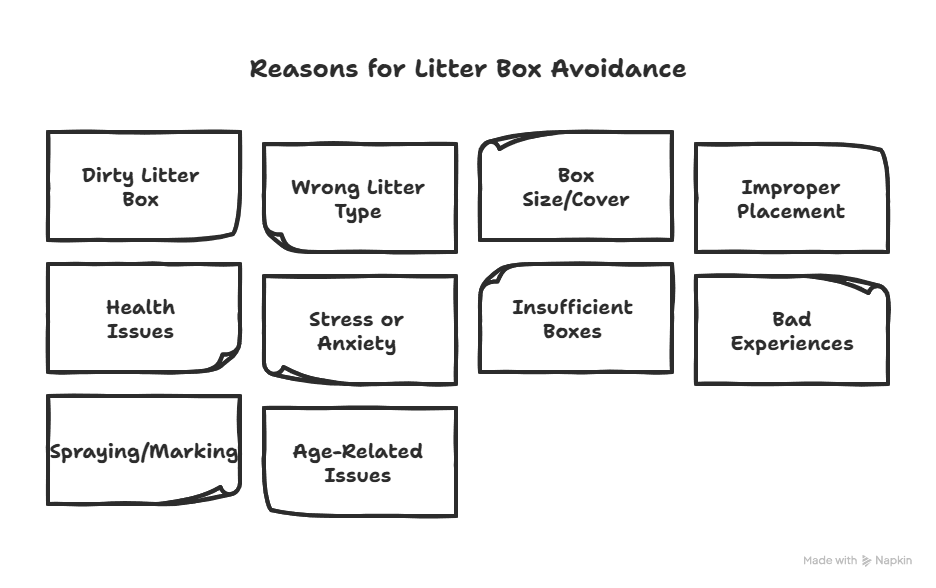
Introduction
Why Won’t My Cat Use the Litter Box?
Few frustrations compare to a cat that will no longer use a litter box. You scoop it out, you spend money on nice litter, and still, your cat finds your carpet, your bed, or your favorite rug to be a more acceptable alternative.
Ring a bell? Don’t worry, you’re not alone. Litter box issues are among the top complaints cat owners have. The good news is that your cat is not doing this to be mean—there is always a reason why.
Here we will talk about 10 of the most common reasons why cats do not use their litter box and, more importantly, how to fix it before your house turns into a giant toilet.

1. The Litter Box Is Too Dirty
Let’s be realistic—cats are neat freaks. If their litterbox is full of waste products, they will find a cleaner place to do their business (i.e., your floor). Would you want to use a dirty bathroom? Not likely.
How to Fix It:
✔ Empty the litter at least once every day.
✔ Clean it once a week—remove all of the litter, wash the box, and refill it with new litter.
✔ Scoop more often or have more litter boxes if you have multiple cats.
2. The Litter Type Is All Wrong
Not every litter is the same, and your cat does have likes and dislikes. Some hate scented litter, while others refuse to walk on some textures.
How to Fix It:
✔ Experiment with other litters (clumping, non-clumping, clay, pine, etc.).
✔ If you’re changing brands, do it slowly—gradually mix the new litter with the previous litter over a week.
✔ Unscented litter tends to be a safer alternative since some cats abhor artificial fragrances.
3. The Litter Box Is Too Small or Covered
If your cat has to fit themselves into a small box, they might well choose to urinate somewhere else that is more spacious. Covered litter boxes can also hold odors and become stinky.
How to Fix It:
✔ Use a large open litter box—especially if you have a big cat.
✔ If you have a covered box, you can take off the top to see if your cat likes it.
✔ The general principle? The more, the merrier!
4. Improper Placement of Litter Box
You would not want to have a bathroom near a noisy washing machine or in a public hallway. Neither would your cat.
How to Fix It:
✔ Place the litter box in a quiet and low-traffic area.
✔ Don’t put it next to their water or food (they don’t like it).
✔ If possible, have several locations so your cat can select where they will be comfortable.
5. Health Issues (UTI, Kidney Disease, etc.)
If your cat is urinating outside of the litter box unexpectedly, a medical condition may be to blame. Urinary tract infections (UTIs), kidney disease, and diabetes are common culprits.
How to Fix It:
✔ Take your cat to the vet at once if it’s having accidents, straining to urinate, or urinating more often than usual.
✔ Be on the lookout for other symptoms like excessive thirst, fatigue, or blood in the urine.
6. Stress or Anxiety
Cats are sensitive animals, and alterations in their surroundings can lead to litter box avoidance due to stress. A new home, a new pet, or even a loud noise can disrupt them.
How to Fix It:
✔ Stick to a consistent routine—cats love predictability.
✔ Use calming aids like Feliway diffusers or soothing cat music.
✔ Provide them with a comfortable space to unwind free of stressors.
7. Insufficient Litter Boxes (Multiple-Cat Homes)
Having more than one cat and a single litter box is a recipe for disaster. Some cats do not want to share, and some will be bullied out of using it.
How to Fix It:
✔ The golden rule: One litter box per cat with a spare (so two cats = three boxes).
✔ Space out litter boxes—do not have all of them in one room.
8. Bad Experiences with the Litter Box
If your cat was startled by something while in the litter box (e.g., a sudden noise or a painful urinary tract infection), they will probably link it to fear and will steer clear of it.
How to Fix It:
✔ Move the litter-box to another location and introduce it gradually.
✔ Reward them with praise or treats each time they play with the box.
9. Spraying & Marking Behavior (Unneutered Cats)
Unspayed or unneutered female and male cats will frequently spray to mark their territory if other cats are around.
How to Fix It:
✔ Spay or neuter your cat—this will reduce marking behavior significantly.
✔ Clean sprayed areas with enzyme-based cleaners to remove odor.
10. Senior Cats & Kittens (Age-Related Issues)
Old cats with arthritis can struggle to step up into high-sided litter-boxes, while kittens might just need more training.
How to Fix It:
✔ For elderly cats, use low-entry litter boxes.
✔ Reward good litter-box behavior with treats and praise for kittens.
Quick Fix Checklist for Litter Box Issues
✅ Daily scoop & weekly deep clean
✅ Experiment with other litter types
✅ Move the box to a quiet and cozy location
✅ Provide adequate litter boxes (1 per cat + 1 extra)
✅ See a veterinarian if medical complications are suspected
✅ Use positive reinforcement to encourage litter box use
Also Read - Ragdoll Cats - The Ultimate Lap Cat with a Sweet Personality
Final Thoughts: Your Cat Isn’t Being Mean to You!
Litter box troubles can be infuriating, but don’t forget—your cat is not doing it to make you mad. They’re trying to tell you something.
By identifying why it’s happening and making small modifications, you can fix the problem and have your cat back to normal.
Ever had to deal with litter-box issues? Share your experience in the comments below—your advice might help another cat owner! 🐾💬




